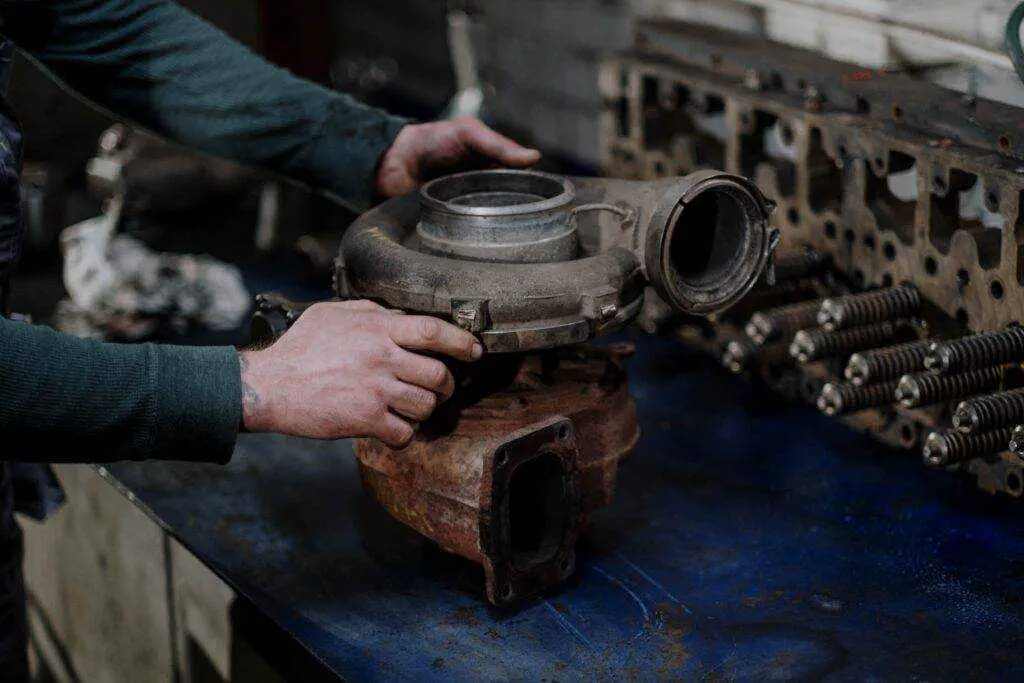Why Is My Gas Pedal Stiff؟۔ A stiff gas pedal can make driving frustrating and even dangerous. When you step on the gas, you expect the pedal to depress smoothly and the car to accelerate. But with a stiff pedal, you have to press extra hard to get the car moving.
What causes gas pedal stiffness and how can you fix it? Let’s explore the common culprits behind a stiff accelerator pedal and the steps you can take to get your pedal working properly again.
Causes of a Stiff Gas Pedal
There are several potential causes of Why Is My Gas Pedal Stiff:
- Dirty Throttle Body
- Jammed Throttle Cable
- Obstructions Behind the Pedal
- Faulty Pedal Assembly
- Issues with Drive-by-Wire System
Dirty Throttle Body
The most common reason for Why Is My Gas Pedal Stiff
is a dirty throttle body. The throttle body is a key component of the fuel system and regulates air intake into the engine. It contains a throttle plate that opens and closes to control airflow.
Over time, the throttle plate can become caked with carbon deposits, dirt, and grime. This restricts the movement of the plate, making it harder to open the throttle when you press the gas. The pedal will feel stiff and unresponsive.
A dirty throttle body can cause other issues like delayed acceleration, poor fuel economy, rough idle, and engine performance problems.
The throttle body is located between the air filter and the intake manifold. It gets dirty over time from airborne debris and fuel residue passing through the system. Infrequent air filter changes and lots of stop-and-go driving accelerate the buildup of gunk on the throttle plate.
Jammed Throttle Cable
In older vehicles that use a physical throttle cable instead of electronic throttle control, a jammed cable can cause pedal stiffness.
The throttle cable connects the gas pedal to the throttle body. When you press the pedal, it pulls on the cable and opens the throttle. If the cable becomes bent, frayed, or obstructed, it can get stuck and not move smoothly.
Signs of a jammed throttle cable include a gas pedal that’s hard to push, sticks halfway, or won’t return to an idle position when released. You may be able to loosen up a stuck cable by lubricating it, but a damaged cable usually needs replacement.
Obstructions Behind the Pedal
Take a look under the gas pedal with a flashlight. Is anything blocking it from moving freely?
Common obstructions include:
- Debris like rocks or dirt
- A twisted or bunched-up floor mat
- The driver’s shoe or pant leg catching on the pedal
Construction workers and gardeners tend to get pebbles and mud lodged behind the pedal. Floor mats that aren’t secured can slide forward and get stuck underneath. Simply clearing any obstructions behind the pedal can immediately improve its motion.
Faulty Pedal Assembly
The gas pedal assembly includes mechanical parts like return springs, bearings, bushings, and pivots. These components can suffer wear and tear over time.
If a spring breaks or a pivot joint fails, it will directly impact the pedal’s operation. A broken return spring may prevent the pedal from coming back up. A worn pivot can lead to excessive looseness or resistance.
Replacing individual pedal parts is possible on some vehicles. However, the entire assembly may need to be swapped out in certain models. This can be more difficult since the pedal assembly extends through the firewall into the engine bay.
Issues with Drive-by-Wire System
In modern drive-by-wire vehicles, there is no direct mechanical connection between the pedal and throttle. Everything is electronic.
Sensors on the gas pedal send signals to a computer called the electronic control module (ECM). The ECM then operates electric motors that open and close the throttle valve.
Problems in this electronic system can manifest as a stiff pedal. Some examples of why is my gas pedal stiff include:
- Faulty pedal position sensor
- Bad throttle actuator motor
- Defective wiring and connections
- Software glitches
Diagnosing drive-by-wire issues requires professional scan tool testing. The pedal may feel stiff but the true culprit is an electronic component failure.
How to Fix a Stiff Gas Pedal
Don’t ignore a stiff gas pedal or just pump the pedal hoping to loosen it up. Getting to the root cause is important for safe driving. Here are the steps for diagnosing and fixing a stiff accelerator pedal.
Inspect Under the Pedal
The first thing to check is if anything is obstructing the pedal’s range of motion.
- Press down on the pedal with your hand while shining a flashlight underneath.
- Look for debris, floor mat interference, or mechanical binding.
- Remove any obstructions. Test the pedal again.
If the pedal moves freely by hand, obstruction is likely the problem. Cleaning it out can restore a normal pedal feel.
Check Throttle Body
A dirty throttle body is the #1 cause of why is my gas pedal stiff. Removing and cleaning the throttle body is the next step in diagnosing pedal stiffness.
- Locate the throttle body housing on the engine. It has an electrical connector and air ducts attached.
- Disconnect the negative battery cable before starting work.
- Disconnect the electrical connector and any hoses or clamps.
- Remove the mounting bolts and carefully detach the throttle body.
- Clean all surfaces and the throttle plate with throttle body cleaner and rags.
- Make sure the throttle plate can fully open and close freely after cleaning.
- Reinstall the freshly cleaned throttle body and reconnect everything.
Take your time cleaning the throttle body thoroughly including the smallest crevices. Any leftover gunk can re-stick the throttle plate.
If the pedal operation improves significantly after cleaning, you’ve found the culprit.
Inspect Throttle Cable
For older vehicles with throttle cables:
- Follow the cable from the pedal to the throttle body.
- Check for kinks, fraying, or obstructions along the cable housing.
- Make sure the cable can move smoothly when the pedal is pressed.
- Lubricate with penetrating oil or cable lubricant.
- Consider replacing severely damaged cables.
Adjusting or replacing a worn-out cable can help restore proper throttle function.
Scan for Trouble Codes
For drive-by-wire vehicles, grab an OBD2 scanner and pull any diagnostic trouble codes (DTCs) related to the accelerator system.
Common codes include:
- P2138 – Accelerator Pedal Position Sensor fault
- P2111 – Throttle Actuator Control System stuck open/closed
- P2109 – Electronic Throttle Control Motor fault
The codes point to the specific sensor, actuator, or connection failure causing pedal issues. Make repairs according to code scanner recommendations.
Why Is My Gas Pedal Stiff- Pedal Assembly Service
With no obvious obstructions or throttle body issues, the pedal assembly itself may need attention.
- Inspect the pedal mechanism for broken or worn parts.
- Check bolts/bushings for looseness causing binding.
- Ensure return springs are intact and provide proper tension.
- Replace worn or damaged components as needed.
See your repair manual for proper pedal assembly maintenance. Replacement may be needed on severely degraded parts.
Adjust the Pedal
Some vehicles have an adjustment procedure for reducing pedal stiffness:
- Locate the pedal height adjuster behind or near the pedal assembly.
- Loosen the lock nuts on the threaded adjuster.
- Turn the adjuster to raise or lower the pedal height as needed.
- Tighten the lock nuts when the proper pedal effort is achieved.
Adjusting pedal height changes the lever ratio, which can dial in the desired pedal stiffness.
When to Call a Mechanic
If you’ve tried all the DIY fixes but the gas pedal is still stiff, it’s time to visit a professional mechanic. Describe the specific symptoms you’re experiencing and the solutions you’ve attempted.
The mechanic has specialized tools to further diagnose issues, including:
- Electronic testing of sensors and throttle actuator
- Scanning for underlying computer fault codes
- Leak testing of vacuum lines
- Pressure testing of the fuel system
- Throttle body synchronization
Be prepared for repairs like throttle body replacement, pedal assembly rebuild kits, or computer reprogramming. A persistent stiff pedal indicates a problem beyond simple at-home remedies.
Driving with a Stiff Gas Pedal

Why Is My Gas Pedal Stiff? Is it safe to drive with a stiff gas pedal? In very limited cases, you may have no choice but to limp the car to the mechanic. But a stiff pedal is generally risky to drive and should be fixed immediately.
The biggest hazard is the pedal sticking wide open as you drive. This typically happens when a badly dirty throttle body finally jams. The engine revs to redline, unable to return to idle.
You can shut off the ignition but will lose power steering and brake assist. Trying to brake hard with the engine racing may overheat the brakes and cause a crash.
A partial pedal stick or delayed return to idle is also dangerous, making smooth stopping tricky. Plus, it’s nearly impossible to maintain a steady speed with an inconsistent gas pedal.
The best option is not to drive the car at all until the stiff pedal is properly diagnosed and repaired. Call for a tow service to transport the vehicle if needed.
Preventing a Stiff Gas Pedal – Why Is My Gas Pedal Stiff
Consistency is key for preventing a stiff gas pedal:
- Maintain the engine air filter – Replace per manufacturer schedule to prevent throttle body contamination.
- Clean the throttle body – Wipe down the throttle plate every 30k miles using throttle body cleaner and a rag.
- Lubricate the throttle cable – If equipped, lube the cable yearly with a specially-made cable lubricant.
- Check pedal operation – Monitor for changes in pedal stiffness and have any issues addressed quickly.
- Scan for trouble codes – Periodically scan the computer system for accelerator-related fault codes.
Following basic maintenance goes a long way in keeping your gas pedal smooth and responsive.
FAQ About Why Is My Gas Pedal Stiff
How do I loosen up my gas pedal?
Spray throttle body cleaner or penetrating oil on the back of the pedal assembly and throttle cable. Let it soak for 15 minutes then tap the gas pedal a few times to help dislodge grime. Do not spray anything directly into the throttle body itself.
Why is my gas pedal hard to push?
The most common causes of a hard-to-press gas pedal are a dirty throttle body, jammed throttle cable, obstructions behind the pedal, and a faulty pedal assembly. Inspecting and cleaning components can often resolve the stiffness.
Can I drive with a stiff gas pedal?
It is generally not recommended to drive with a stiff gas pedal. The pedal could stick wide open and create an extremely hazardous situation. Only drive it if necessary and then with extreme care and low speeds. Have the pedal repaired before normal driving.
My gas pedal is sticky when I first press it – what does this mean?
Stickiness or delayed return to idle on the initial pedal press can point to a throttle body in need of cleaning. Carbon deposits on the throttle plate temporarily stick when sitting overnight. Cleaning the throttle body and plate will restore smooth operation.
Why does my gas pedal feel spongy?
A spongy or soft gas pedal can indicate a problem with the return springs in the pedal assembly. Weak or broken springs allow too much pedal travel. In severe cases, replacement springs or an entire new pedal assembly may be needed.
Key Takeaways – Why Is My Gas Pedal Stiff
- A stiff gas pedal makes acceleration difficult and tiring. Ignoring the problem leads to unsafe driving conditions.
- Several issues like throttle body contamination, cable -obstruction, and pedal assembly failure can cause stiffness.
- Inspecting under the pedal, cleaning the throttle body, and checking cables and return springs can remedy many cases.
- Persistent stiffness needs professional diagnosis for sensor problems, computer faults, leaks, or other hidden issues.
- Maintain the throttle body and pedal assembly to help prevent a stiff pedal from developing.
- Refrain from driving the vehicle until the specific cause of pedal stiffness is fixed for safety.
Getting your gas pedal to function properly is critical for confident driving. By understanding the problem, taking methodical diagnostic steps, and performing preventive maintenance, you can eliminate that stubborn pedal stiffness and get back on the road worry-free.





